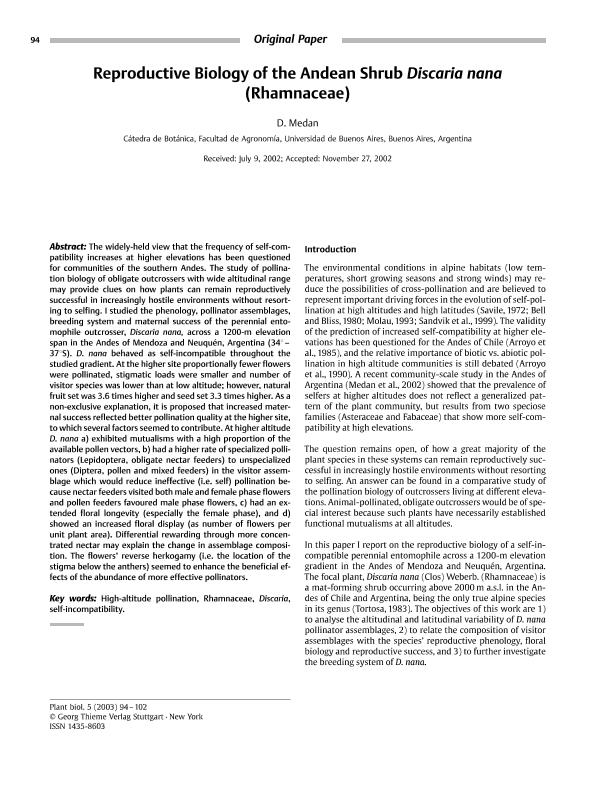Mostrar el registro sencillo del ítem
dc.contributor.author
Medan, Diego

dc.date.available
2022-01-19T12:27:48Z
dc.date.issued
2008-06
dc.identifier.citation
Medan, Diego; Reproductive biology of the andean shrub Discaria nana (Rhamnaceae); Wiley Blackwell Publishing, Inc; Plant Biology; 5; 1; 6-2008; 94-102
dc.identifier.issn
1435-8603
dc.identifier.uri
http://hdl.handle.net/11336/150300
dc.description.abstract
The widely-held view that the frequency of self-compatibility increases at higher elevations has been questioned for communities of the southern Andes. The study of pollination biology of obligate outcrossers with wide altitudinal range may provide clues on how plants can remain reproductively successful in increasingly hostile environments without resorting to selfing. I studied the phenology, pollinator assemblages, breeding system and maternal success of the perennial entomophile outcrosser, Discaria nana, across a 1200-m elevation span in the Andes of Mendoza and Neuquén, Argentina (34°-37°S). D. nana behaved as self-incompatible throughout the studied gradient. At the higher site proportionally fewer flowers were pollinated, stigmatic loads were smaller and number of visitor species was lower than at low altitude; however, natural fruit set was 3.6 times higher and seed set 3.3 times higher. As a non-exclusive explanation, it is proposed that increased maternal success reflected better pollination quality at the higher site, to which several factors seemed to contribute. At higher altitude D. nana a) exhibited mutualisms with a high proportion of the available pollen vectors, b) had a higher rate of specialized pollinators (Lepidoptera, obligate nectar feeders) to unspecialized ones (Diptera, pollen and mixed feeders) in the visitor assemblage which would reduce ineffective (i.e. self) pollination because nectar feeders visited both male and female phase flowers and pollen feeders favoured male phase flowers, c) had an extended floral longevity (especially the female phase), and d) showed an increased floral display (as number of flowers per unit plant area). Differential rewarding through more concentrated nectar may explain the change in assemblage composition. The flowers' reverse herkogamy (i.e. the location of the stigma below the anthers) seemed to enhance the beneficial effects of the abundance of more effective pollinators.
dc.format
application/pdf
dc.language.iso
eng
dc.publisher
Wiley Blackwell Publishing, Inc

dc.rights
info:eu-repo/semantics/openAccess
dc.rights.uri
https://creativecommons.org/licenses/by-nc-sa/2.5/ar/
dc.subject
DISCARIA
dc.subject
HIGH-ALTITUDE POLLINATION
dc.subject
RHAMNACEAE
dc.subject
SELF-INCOMPATIBILITY
dc.subject.classification
Otras Ciencias Agrícolas

dc.subject.classification
Otras Ciencias Agrícolas

dc.subject.classification
CIENCIAS AGRÍCOLAS

dc.title
Reproductive biology of the andean shrub Discaria nana (Rhamnaceae)
dc.type
info:eu-repo/semantics/article
dc.type
info:ar-repo/semantics/artículo
dc.type
info:eu-repo/semantics/publishedVersion
dc.date.updated
2022-01-06T15:04:24Z
dc.journal.volume
5
dc.journal.number
1
dc.journal.pagination
94-102
dc.journal.pais
Reino Unido

dc.journal.ciudad
Londres
dc.description.fil
Fil: Medan, Diego. Universidad de Buenos Aires. Facultad de Agronomía. Cátedra de Botánica General; Argentina. Consejo Nacional de Investigaciones Científicas y Técnicas; Argentina
dc.journal.title
Plant Biology

dc.relation.alternativeid
info:eu-repo/semantics/altIdentifier/url/https://onlinelibrary.wiley.com/doi/abs/10.1055/s-2003-37980
dc.relation.alternativeid
info:eu-repo/semantics/altIdentifier/doi/http://dx.doi.org/10.1055/s-2003-37980
Archivos asociados
